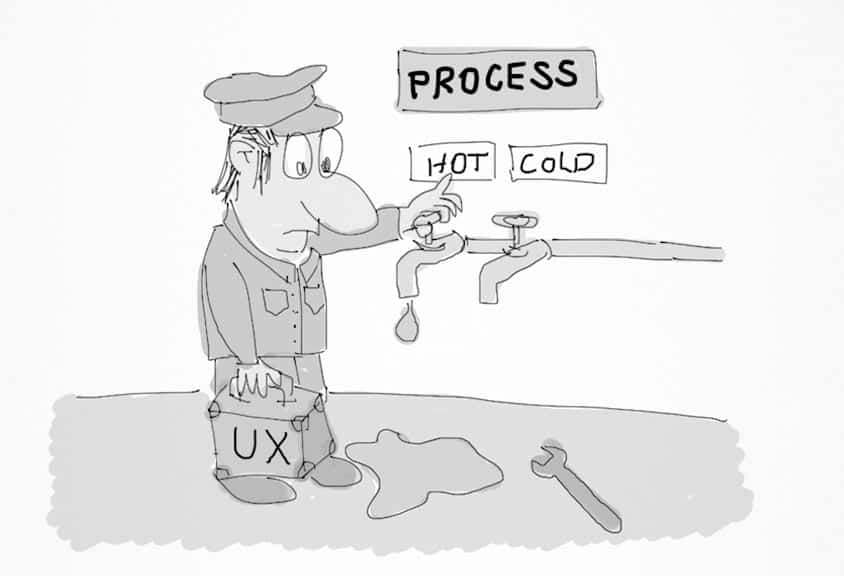I once was subcontracted by a large corporate as the sole user experience designer in a team of designers and developers. This isn’t an unusual situation for a UXer, but this role came with unique difficulties.
My mandate was to help the project team “create a well-designed product that met user needs.” While there was a lot of support for this, after a few weeks it became obvious that much of it was lip-service, and there were more than a few challenges in actually achieving this goal. It was easy for the organisation to say the right things and use the right buzzwords, but getting things actually moving in the right direction was hard.
As the sole user-centred designer with any experience in the team, I noticed that the support I received on applying user experience principles beyond basic usability and accessibility ran hot and cold. My attempts to encourage people to care about the fact that their web application was only part of the user’s larger experience of a situation were often falling on deaf ears.
Pushback like this is pretty normal when introducing UX to a new organisation—it’s natural to resist change. However, by applying some creativity and strategic thinking, these hurdles can be overcome. Setting the right expectations, getting buy-in and then charting a course through it all to demonstrate achievement goes a long way towards “earning your keep” and creating positive change in a difficult environment.
Principles Trump Process
The biggest challenge I encountered was the internal processes used by the team. These processes were in place for a number of reasons: the complicated technical infrastructure we were stuck with, the varied backgrounds and experiences of the team members’ and the dominant culture of the workplace. It was clear that I, as a lone user experience designer, wasn’t going to change any of that very quickly, and in the meantime I needed to be scoring clear goals.
What I learnt after several unsuccessful attempts to bang my head against the process wall is that well-applied UX principles trump process every time.
Here’s why:
- Principles can be used to determine both the end product as well as the journey you use to get there.
- Processes can adapt to change, but principles are a guiding light. They define the goal for what your user-centred approach should achieve—something that is sorely needed when processes aren’t working so well.
- Process is often the first thing people blame when things don’t work, but too much energy goes into changing it that could instead be fed into developing the relationships and understandings that underpin your role.
- The processes needed for UX are rarely in place for an organisation that is new to user-centred design.
- Even if you do have the “right” processes, if people aren’t participating and don’t have the right attitude, they won’t work anyway.
If you’re working as a sole user advocate in a team, it’s your attitude, not your job description, that will make the difference.
Here are four principles for going it alone in a business new to UX, based on my experiences:
-
Listen up!
As Grandma used to say: “You have two ears, but only one mouth”. People often describe UX practitioners as facilitators, and as the reconcilers of creative and technical tensions that deliver a satisfying experience for users. To fulfil this role, you need to understand the points of view of the people you’re talking with.
This requires that you shut up and actively listen to others as they describe their understandings and ideas, their previous attempts to solve the design problem, to implement a technical solution, or the many pressures, perspectives and priorities you may be facing.
-
Be the voice of honesty and open-mindedness.
Always have time for talking with your team. Keeping your head down to achieve your tasks and to look like you’re busy and productive won’t end up convincing people that you’re worth your wage. It may disengage you from the team and make you seem stand-offish. UX is a collaborative discipline, so make sure you bring lots of team spirit with you to a project.
-
Get practical and collaborative.
When the stakes are high, discussions can become lively when people latch onto a pet subject or solid belief. Voicing opinions is fine, as long as people in your team all have the same goal in mind. It doesn’t matter if they have different ideas about how to get there—your job is to turn these opinions into tangible tasks that can be discussed, tested and refined. If you can quickly sketch or prototype an idea, you can save a lot of time arguing when you may already agree fundamentally. Plus you’ll get the benefits of iterating a design to boot.
-
Make it good enough, but no better.
As a UXer, your work is never really finished. Conversations about what is most important to get right will be more fruitful than an endless obsession with making things perfect. Knowing when you’re done—and when you can let others take over from what you’ve begun—is far more satisfying. Getting the foundations, attitudes and direction right will set the stage for the rest of the team to carry the vision through the rest of their work.
Keeping these principles in mind keeps me sane during the hustle of a new or difficult working environment. I hope you can apply these too, and would love to hear about your experiences. Let me know in the comments!

